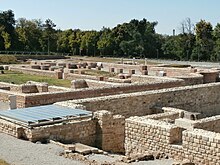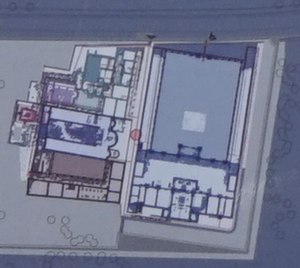 Legionary fortress with later Bishop's palace and cathedral Legionary fortress with later Bishop's palace and cathedral | |
 | |
| Coordinates | 43°36′46.4″N 25°23′39.4″E / 43.612889°N 25.394278°E / 43.612889; 25.394278 |
|---|---|
| Type | Settlement |
| Site notes | |
| Ownership | Public |
| Public access | Yes |


Novae was initially one of the few great Roman legionary fortresses along the empire's border, forming part of the defences (limes Moesiae) along the Danube in northern Bulgaria. The settlement later expanded into a town in the Roman province of Moesia Inferior, later Moesia Secunda.
It lies about 4 km east of the modern town of Svishtov.
The fortress is one of the few along the limes to have been excavated and now open to the public.
Location and topography
Novae is situated on the southern bank of the Danube at Pametnicite near Svishtov.
The legionary fortress (castra legionis) covers an area of 18 hectares on a slope towards the river-bank, its highest point in the southern part of the site being 30m higher. Its topography resulted in terraced levels within the defensive walls.
At present mainly the central part of the site has been excavated and restored.
History and archaeology
Permanent Roman military presence in the Lower Danubian region started after Augustus had established himself as sole ruler of the Roman state in 30 BC and adopted a strategy to move the empire's south-eastern European border from Macedonia to the line of the Danube providing a major river supply route between the Roman armies in the region. Marcus Licinius Crassus fought a successful campaign against the Moesi and Augustus formally proclaimed victory in 27 BC. The region was organised as the Roman province of Moesia in the last years of Augustus' reign, around 6 AD.
Around 45 AD Legio VIII Augusta took part in the suppression of the Thracian uprising, and founded its fortress at Novae. The site was chosen to control a river crossing and the key section of the Danube from the mouth of the Osum River (Asamus) up to the mouth of the Yantra River, near Iatrus, a choice that was justified by later successes.
After the death of Nero, the dislocation of many legions within the Empire resulted in replacement by emperor Vespasian in 69–70 AD of Legio VIII Augusta by Legio I Italica, which stayed in Novae at least to the 430s. In 86 the province was divided and Novae, together with Durostorum, became one of two legionary bases within the borders of Moesia Inferior. During the Dacian wars of Domitian (85–89) Novae did not suffer significant damage, which may indicate that the main operations took place in the western and eastern part of the province. The legion was followed by craftsmen, servicemen, traders and other camp followers who settled down in the fortress vicinity creating the canabae legionis. At the same time another settlement (vicus) emerged ca. 3 km to the east of the camp, in the place Ostrite Mogili
Novae served as a base of operations for Roman campaigns against Barbarian tribes including Trajan's Dacian Wars, and the last time during Maurice's Balkan campaigns. The legion was also responsible for bridge construction over the Danube.
Until the Flavian period the fortress walls were built from earth and wood. During the campaigns of Trajan the walls were replaced by stone wall up to 3m thick with square towers. Apart from the new defensive walls, the monumental building of headquarters (principia) with the new Trajanic basilica, and the new building of a hospital (valetudinarium) were built at the place of the former Flavian baths (thermae). It is possible that during the Antonine period the legion controlled the area beyond the Yantra River. The most prosperous times for Novae, as well as for the province, were during the Severan dynasty.
In 250 Novae was attacked by the Goths of Cniva but escaped damage, although the canabae and the nearby settlements were completely destroyed. In the second half of the 3rd century Novae was systematically attacked and destroyed by barbarians. From the 4th century onwards when the legion was divided into detachments occupying small forts and fortlets, civil buildings constituted the main part of internal buildings of Novae. The new streets with pavements were built from re-used stone, often bearing inscriptions. Many glass workshops were established, both in the town, as well as in its surroundings. At a certain moment the area of 8 ha to the east of the legionary base was surrounded by the new defensive walls.
The latest evidence for the presence of the legion is dated by a series of inscriptions from 430, 431 and 432.
In the late 5th and 6th centuries Novae was the seat of a bishop. The cathedral and neighbouring buildings were built over the legionary barracks west of the former legionary headquarters. The last period of prosperity was during the reign of Justinian (527–565) when the defensive walls were rebuilt and reinforced, but the attacks of Slavs and Avars eventually end the existence of the ancient town. In 9th–11th centuries the church and a cemetery existed in the western part of the town.
Novae is supposed to be the home of the saint named Lupus, who is venerated in Greek and Romanian traditions.
Recent excavations have revealed the via principalis and other buildings. In 2018, possible Roman soldiers' burials were discovered near Novae.
Civilian settlements and the extramural area
The civil settlement (canabae legionis) were situated to the west of the legionary base. Another civil vicus has been located over 2 km east of the fortress, at Ostrite Mogili. One of the settlements was granted municipal rights, but only one inscription testifies this status. A splendid villa to the west of the defensive walls, within the canabae, could have been an official residence was destroyed by the Gothic invasions in mid-3rd century.
Other minor settlements and places of cult were located but not systematically excavated.
The area to the south-east and east of the fortress was occupied by the necropolis, which was recently excavated., while the military amphitheater is postulated on the north-eastern side of the camp.
Water supply to the fortress, particularly the baths including the nearby nymphaeum and to the town was ensured by three known aqueducts, one of which was at least 9 km long and fed the distribution tank (castellum divisorum) at the south-east corner of the fortress.
During the late Roman period the town was enlarged by a new line of defensive walls and covered 26 hectares jointly with the former legionary base.
Name of the site
Novae (Novae) might have referred to the canabae (canabae legionis I Italicae Novae), when the fortress itself had the name castra legionis I Italicae. Literary sources give the name of Novae or, in accusative form Novas, and the Greek transcription Nόβας given by Procopius, Theophanes Confessor and Anonymous Ravennatis. The Greek form Nόβαι appears rather rare; an earlier form mentioned by Ptolemy is Nooῦαι.
One hypothesis derives the name from Νόης Nóēs, a river mentioned by Herodotus, which is then identified with the stream (now variously known as Dermendere, Tekirdere, Golyamata Bara, or Belyanovsko Dere) at whose mouth the fortress was located.
References
- Res Gestae 30
- Cassius Dio 51.23.3 ff.
- Cassius Dio, lv.29
- J. Kolendo, Claude et l’annexion de la Thrace, in: Claude de Lyon empereur romain. Actes du Colloque Paris-Nancy-Lyon. Novembre 1992, Paris 1998.
- Kolendo, J. 2008. Novae during the Goth raid of AD 250/1 (Iordanes, Getica 101-103). In: Derda, T. / Dyczek, P. / Kolendo, J. (eds.). Novae: Legionary Fortress and Late Antique Town, vol. I: A Companion on the Study of Novae.Warsaw. 117-131.
- A. Tomas, Living with the Army I. Civil Settlements near Roman Legionary Fortresses in Lower Moesia, Warszawa 2017
- Kolendo, J. 2008. Novae during the Goth raid of AD 250/1 (Iordanes, Getica 101-103). In: Derda, T. / Dyczek, P. / Kolendo, J. (eds.). Novae: Legionary Fortress and Late Antique Town, vol. I: A Companion on the Study of Novae. Warsaw. 117-131.
- T. Sarnowski, “Drei Spatkaiserzeitliche Statuenbasen aus Novae in Niedermosien” In: Römische Städte und Festungen an der Donau, Akten der Regionalen Konferenz Beograd 16–19 Oktober 2003, edited by M. Mirković, Beograd 2005, pp. 223–230
- Archaeologists Unearth Roman Empire’s Danube Road, Mysterious ‘Fortresslike’ Building in Ancient Novae near Bulgaria’s Svishtov: http://archaeologyinbulgaria.com/2016/10/28/archaeologists-unearth-roman-empires-danube-road-mysterious-fortresslike-building-in-ancient-novae-near-bulgarias-svishtov/
- "Possible Roman Soldiers' Burials Unearthed in Bulgaria". Archaeology. 3 October 2018.; A. Tomas, Connecting to Public Water: The Rural Landscape and Water Supply of Lower Moesia, Archaeologia Bulgarica 15/2, 2011, 59–72
- A. Tomas, Living with the Army I. Civil Settlements near Roman Legionary Fortresses in Lower Moesia, Warszawa 2017, p.41; https://canabaenovae.wordpress.com/novae/extramural-area/canabae/
- A. Tomas, Living with the Army I. Civil Settlements near Roman Legionary Fortresses in Lower Moesia, Warszawa 2017, p.41; S. CONRAD, Archaeological Survey on the Lower Danube: Results and Perspectives, in: Surveying the Greek Chora. The Black Sea Region in a Comparative Perspective. International Conference, Sandbjerg, Denmark (31 August – 3 September 2003), Aarhus 2006 , 309-331. https://canabaenovae.wordpress.com/novae/extramural-area/ostrite-mogili/
- A. Tomas, Living with the Army I. Civil Settlements near Roman Legionary Fortresses in Lower Moesia, Warszawa 2017, p. 159ff.
- A. Tomas, Living with the Army I. Civil Settlements near Roman Legionary Fortresses in Lower Moesia, Warszawa 2017, p. 81-85.
- A. Tomas et al., The eastern necropolis of Novae, Archaeologia Bulgarica 24/3, 2020, 37–63
- A. Tomas, Living with the Army I. Civil Settlements near Roman Legionary Fortresses in Lower Moesia, Warszawa 2017, p. 76
- Ivan Tsarov: The Aqueducts in the Bulgarian Lands, 2nd-4th century AD, p 76, ISBN 9786191681907; A. Tomas, Connecting to Public Water: The Rural Landscape and Water Supply of Lower Moesia, Archaeologia Bulgarica 15/2, 2011, 59–72
- "The Late Roman town". 26 April 2013.
- Itin. Ant. 221, 4; Jord., Get., 101, Tab. Peut. VIII, 1; Not. Dign. Or. XL, 30, 31; Eugipp., 44, 4
- Procopius De aed. IV, 11
- Theophanes Confessor< Chron., p. 423, 426, 436, ed. J. Classen
- Anonymous Ravennatis IV, 7
- Hierocl. Synecd. 636, 6; Theoph. Sim. VII, 2.16; VIII, 4.3-4
- (Ptol. III, 10.10
- T. Sarnowski, The Name of Novae in Lower Moesia, with a contribution by D. Dragoev, Archeologia, 2007 (2009), 58, 15-23
- Velkova, Živka (1976). "Der thrakische Ursprung des Namens der Stadt Novae (Moesia inferior)". Klio. 58 (1–2): 41–44. doi:10.1524/klio.1976.58.12.41. S2CID 194399395.
Literature
- E. GENČEVA, P”rviât voenen lager v Novae (Dolna Miziâ), Sofia-Warszawa 2002.
- L. PRESS, T. SARNOWSKI, Novae. Römisches Legionslager und frühbyzantinische Stadt an der unteren Donau, Antike Welt 21, 1990, 22.
- T. SARNOWSKI, Fortress of the Legio I Italica at Novae, Akten des XI. Intern. Limeskongresses (Szekesfehervar, 30.8.–6.9.1976), 415–424.
- T. SARNOWSKI, La fortresse de la legion I Italica et le limes du sud-est de la Dacie, Eos 71, 1983, p. 265–276.
- T. SARNOWSKI, Novae in the Notitia Dignitatum, Archeologia (Warszawa) 57, 2007 (2008).
- T. SARNOWSKI, The Name of Novae in Lower Moesia, Archeologia (Warszawa) 57, 2007(2008).
- A. TOMAS, Living with the Army, vol. I. Civil Settlements near Roman Legionary Fortresses in Lower Moesia, Warszawa 2017.
- IGLNov Inscriptions grecques et latines de Novae (Mésie inférieure), J. Kolendo, V. Božilova , Bordeaux 1997.
External links
- Research in Novae by the Faculty of Archaeology University of Warsaw Expedition
- Excavations of the necropolis
- Bulgaria Travel - Novae Roman Town
- Archaeological Discoveries in Novae Continue
- Ancient Rome Festival Recreates Legionnaires' Fights in Bulgaria's Svishtov
- Mending bodies, saving souls: a history of hospitals
- BULGARIA: Heritage in Danger
- Festival of Ancient Heritage, Svishtov 2009
- Festival of Ancient Heritage and Hrubieszow Museum